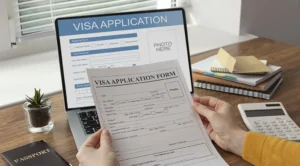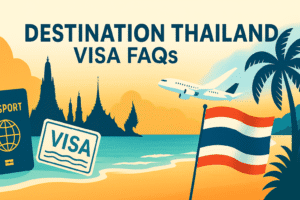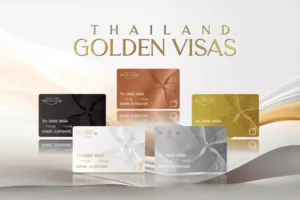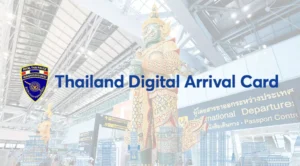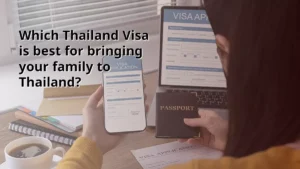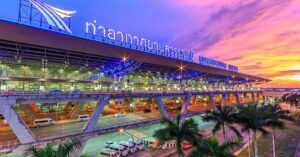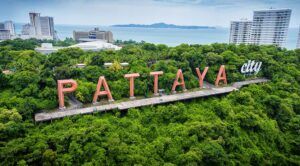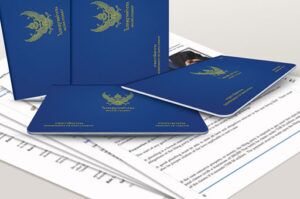If you’re a foreigner staying in Thailand for any amount of time, you’ll deal with a lot of immigration paperwork. These forms play a key role in determining how long you can stay, where you’re allowed to travel, and whether your visa stays valid.
The problem is that there are a lot of them, and the Thai bureaucracy is notoriously complex. Some forms are filled out when you arrive, others are for when you move house, and a few are only needed if you’re leaving and planning to come back. Failure to comply may result in fines or visa revocation.
This FAQ covers the most common immigration forms tourists and expats need to deal with. You’ll see what each form is for, who has to file it, and what can happen if you skip it. Whether you’re here short-term or living in Thailand full time, this guide helps you avoid the mistakes that cause problems.
What is the TM30 Form?
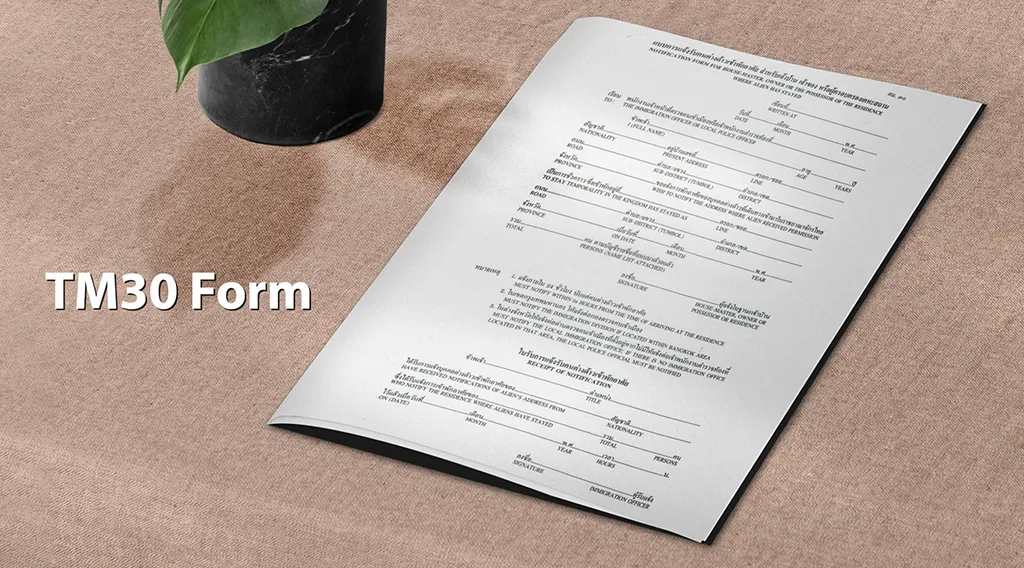
The TM30 form tells Thai Immigration where you’re staying. If you’re a foreigner and you sleep somewhere that’s not a hotel, your landlord has to report it within 24 hours.
It helps the government monitor residency and prevent visa overstays or illegal activity. It also comes up during visa extensions, 90-day reports, and important appointments.
Who is responsible for filing the TM30?
The landlord is supposed to file it. That could be the condo owner, house owner, or the manager of your serviced apartment. Hotels report this automatically. Still, even if you’re not responsible for filing the TM30, you must ensure it’s been done.
If it’s missing, Immigration might deny your visa extension or require you to pay a fine. In some cases, you can file it yourself if your landlord gives you a signed proxy form.
When do you need to file a TM30?
The TM30 isn’t a one-time task you can ignore afterward. If your address changes, you’re expected to file it again. Immigration uses it to keep track of where foreigners are staying, and not updating it can lead to fines.
You need a new TM30 if any of these happen:
- You move to a different address
- You come back to Thailand from a trip abroad
- You return home after staying at a hotel or guesthouse
Even if you own your home in Thailand, you still have to file a TM30 on yourself. The rule applies to all foreigners, with no exceptions.
How do you file a TM30?
There are three ways:
- In person at your local immigration office
- Online through the Immigration Bureau’s portal
- Using the mobile app called Section 38 (only available in the Thai app store)
Your landlord, or their proxy, needs to prepare:
- Copy of their Thai ID or passport
- Copy of the house registration (Tabien Baan) or title deed
- Rental agreement
- Your passport info and visa stamp
Once the form is approved, they get a small receipt. That is your proof of registration, so keep a copy of it with your passport.
What is the Thailand Digital Arrival Card (TDAC) and why do you need it?
The TDAC is the Thailand Digital Arrival Card that replaced the old TM6 paper form. Starting May 1, 2025, every non-Thai traveler must complete the TDAC before entering the country.
It helps Immigration screen arrivals and track where you’re staying, and it also includes a short health check. If you don’t complete it before arrival, expect delays at passport control until you do.
Who has to submit a TDAC registration?
If you’re not a Thai citizen, you need to file it. That includes tourists, expats, and travelers entering without a visa. It doesn’t matter if you live here or are just visiting, or if you arrive by plane, bus, or ferry. The TDAC is required every time you enter. If you’re traveling as a family, each person, including children, must submit one, but you can submit the forms together online.
When should you complete the TDAC?
You can submit your TDAC within 72 hours before your scheduled arrival. If you show up at the airport without it, you can still fill it out using your phone, but it may slow things down.
Ideally, complete it at least one day before your flight. You don’t need to print anything, just keep the confirmation on your phone.
What do you need to fill out the TDAC?
Before you start, gather these:
- Your passport
- Your visa (if you have one)
- Your flight or travel info
- The address where you’ll be staying
- Details about countries you’ve visited in the past two weeks
- Yellow fever vaccine proof if you’re coming from an at-risk country
The form takes just a few minutes if you have this ready.
Is the TDAC the same as a visa?
No. The TDAC is not a visa. It doesn’t let you stay in Thailand. It’s more like a pre-arrival check. You still need the right visa or be eligible for visa exemption to enter.
Can you update or resubmit your TDAC?
Yes, but not everything. You can fix your address or travel dates, but not your name, passport number, or birthdate. If you make a mistake in those, you need to file a new TDAC. There’s no penalty for re-filing, but only the correct version will be accepted.
What’s the difference between the TDAC and TM30?
The TDAC logs your arrival into Thailand. The TM30 logs where you live once you’re in the country. If you are simply visiting Thailand and staying in a hotel, the TM30 is not required, but any foreigner entering Thailand must complete the TDAC.
Both are required for certain tasks such as extending your visa, so it’s best to keep good records of both.
TM88 (Visa On Arrival)
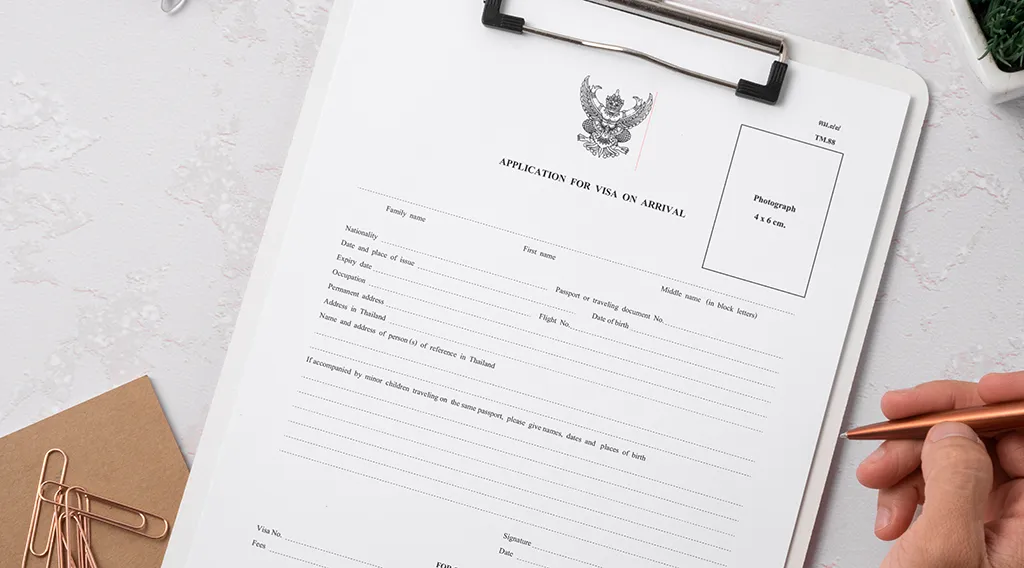
The TM88 form is used to apply for a Visa on Arrival, a short-term visa ideal for visitors who do not qualify for visa exemption.
What is the Visa on Arrival, and who can use it?
The Visa on Arrival lets travelers from certain countries enter Thailand without applying for a visa in advance. This visa is only for tourism, and you can get it when you land at the airport or cross the border.
To use this, your passport must be from one of the approved countries. You also need to show that you’re visiting for a short stay by showing an onward ticket.
What are the requirements for a Visa on Arrival?
To apply for a Visa on Arrival (VOA), you must prove that you’re entering Thailand as a short-term tourist and that you meet the basic entry conditions. Immigration officers will check your documents at the border or airport.
You need to meet these conditions:
- Have a passport valid for at least 30 more days
- Bring a passport photo (4 x 6 cm) taken within 6 months
- Show proof of where you’re staying in Thailand
- Have at least 10,000 baht (or 20,000 baht if traveling with family)
- Show a confirmed return or onward ticket that leaves Thailand within 15 days
- Be a citizen of an eligible country for the VOA program
You don’t need a vaccine certificate or proof of COVID insurance, but medical care is not free. Consider travel insurance in case you need treatment.
Where can you get a Visa on Arrival?
You can get this visa at most international airports and some land borders. That includes Suvarnabhumi, Don Muang, Chiang Mai, Phuket, and U-Tapao airports. You can also apply at checkpoints like Mae Sai and Nong Khai.
Visa counters are usually near the immigration area. Proceed to the Visa on Arrival queue, complete the TM88 form, and present the required documents.
How much does the Visa on Arrival cost?
The fee is 2,000 baht. You must pay in cash, and it must be Thai baht. There’s no refund if your application is denied. It’s better to exchange money before you get here. You might find a counter at the airport, but many land borders don’t have that option.
How long can you stay with a Visa on Arrival?
This visa gives you up to 15 days in Thailand. If you want more time, you’ll need to leave and come back, or apply for a longer-term visa from a Thai embassy outside the country. You can’t switch this visa to something else from inside Thailand. Once the 15 days are up, you need to leave.
What is the TM87 Form?
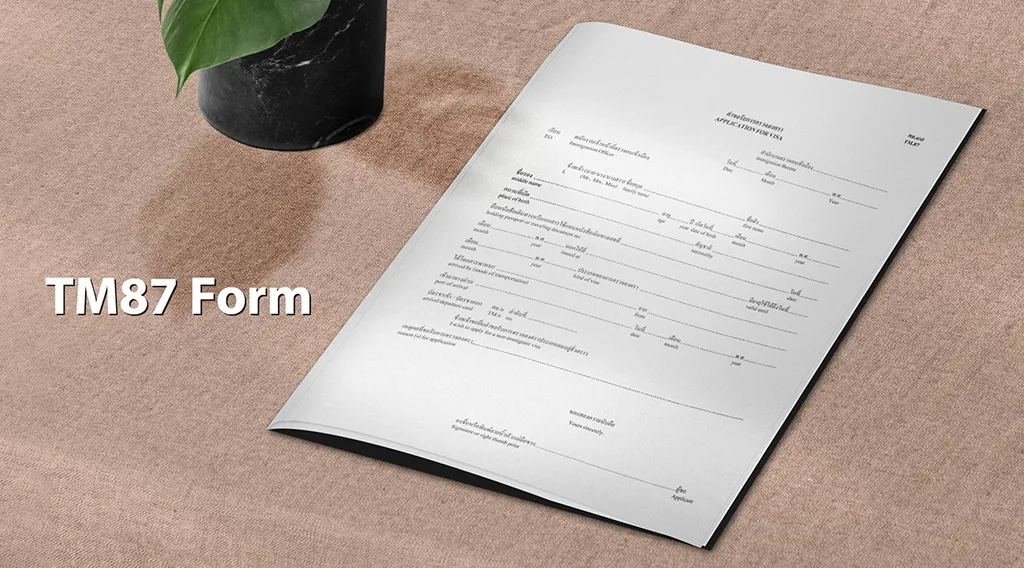
The TM87 is the visa application form you need when applying for a Thai tourist visa from outside Thailand at a Thai Embassy or Consulate. Therefore, you must submit TM87 before you travel, not when you land.
When do you use the TM87 Form?
Use TM87 when you’re applying for:
- A single-entry tourist visa
- A multiple-entry tourist visa
You need to fill it out and submit it with your other documents to a Thai Embassy or Consulate. This is often required if you’re staying more than 30 days or if you’re not from a country that qualifies for visa-free travel.
What information do you need to complete the TM87?
Before you fill out the TM87, gather all the information you’ll need. The form asks for specific details, and any mistakes can lead to delays or a rejected application.
You must provide:
- Personal info (full name, nationality, passport details)
- Travel plans (entry date, exit date, and address in Thailand)
- Purpose of visit
- Details of your financial situation
- Your photo (passport size, taken in the past 6 months)
Make sure everything is accurate. If the details don’t match your flight or hotel booking, your visa could be denied.
Where do you submit the TM87?
You’ll need to submit the form to a Thai Embassy or Consulate in your home country or wherever you’re allowed to stay. Some embassies take online applications, while others ask for a printed form and an appointment. Check their website first so you don’t waste time or run into problems.
What is the TM7 Form used for?
The TM7 is the form you use to apply for a visa extension inside Thailand. Most people use it to extend their tourist visa or extend the 30-day visa exemption stamp. You fill out TM7 when you want to stay longer than your original entry allows. This must be done at a local immigration office before your current stay expires.
When should you submit the TM7?
You should apply at least 7 days before your visa or entry stamp expires. Immigration doesn’t accept late applications. If you miss the deadline, you’ll need to leave the country or pay an overstay fine.
Some people line up early in the morning at immigration offices. Bring everything in one visit to avoid delays. Alternatively, you can hire a visa agent to perform this task on your behalf.
What information do you need for TM7?
You’ll need to fill out personal details and answer questions about your reason for staying. You also need to attach:
- A copy of your passport
- A copy of your TM6 or TDAC
- Proof of address (such as a TM30 receipt or hotel booking)
- A passport photo
- A fee of 1,900 baht (in cash)
Tourists usually ask for a 30-day extension, but people on other visas may request longer stays, depending on the visa type.
Where do you submit the TM7 Form?
You must go to a Thai Immigration Office in the province where you’re staying. Some offices require appointments, while others operate on a walk-in basis.
How long can you extend your stay with TM7?
If you entered on a tourist visa or visa exemption, TM7 gives you 30 more days. Some non-immigrant visas allow longer extensions, but those usually need more paperwork and approval.
TM7 is for short-term stays. It doesn’t convert your visa type or allow permanent residency.
What is a TM8 Re-Entry Permit in Thailand?
A re-entry permit lets you leave Thailand and come back without canceling your current visa. If you have a single-entry visa and you exit the country without this permit, your visa will be void.
The TM8 is the form you fill out to apply for this permit. It doesn’t extend your stay, it only protects your current visa from being canceled when you travel.
Who needs a Thai Re-Entry Permit?
You need one if you hold a visa that allows only a single entry. This includes:
- Single-entry tourist visa
- Non-immigrant 90-day visa
- One-year marriage visa
- One-year retirement visa (OA type)
If you’re not sure, check the label on your visa. If it says “single entry,” you must get this permit before leaving the country.
Which visas do not require a re-entry permit?
You do not need a permit if you have a multiple-entry visa. That includes:
- Multiple-entry tourist visa
- Thailand Elite Visa
- Long-Term Resident Visa
- Retirement visa (OX type)
- Thai business visa with multiple entries
These visas let you leave and return as often as you want during their valid period.
Where can you apply for a Thai Re-Entry Permit with TM8?
You can apply at two places:
- Any Thai Immigration Office, before your trip
- At the airport, just before your departure
If you’re applying at the airport, arrive early. The process takes 15 to 30 minutes, depending on how busy it is.
What documents do you need for the TM8 Form?
When you have to fill out the TM8 form, you will need to prepare the following:
- Your passport
- Photocopies of key passport pages
- A passport-size photo
- Your TM6 card or TDAC confirmation
- Your most recent entry stamp
- Extension stamp, if you have one
- Completed TM8 form
Some airports will provide the TM8 form, but it’s better to print and fill it out in advance.
How much does a re-entry permit in Thailand cost?
The fee depends on what type you choose:
- Single re-entry: 1,000 baht
- Multiple re-entry: 3,800 baht
You must pay in cash, and there are no refunds if your travel plans change.
What happens if you leave Thailand without a re-entry permit?
If you leave without one and your visa is single-entry, it’s canceled. That means you’ll have to start over with a new visa to return, unless you qualify for visa exemption or a Visa on Arrival.
This mistake is common and costly. Always double-check your visa type before leaving Thailand.
What is the TM47 Form for?
The TM47 is the form you use to report your current address to Thai Immigration every 90 days. This is required if you are a foreigner who stays in Thailand for more than 90 days, which typically happens if you hold a long-term Thai visa such as a retirement or work visa.
The report helps Immigration track long-term foreign residents. It doesn’t change your visa or extend your stay, it simply confirms you’re still in the country and at the same address.
Who needs to submit a 90-day Report in Thailand?
You must file TM47 if:
- You’ve stayed in Thailand for 90 days or longer
- You hold a non-immigrant visa or a one-year extension
- You haven’t left the country during the 90-day period
If you leave and re-enter Thailand, your 90-day count resets, but you’ll then need to file again 90 days after your return.
When do you submit TM47?
You can file the report 15 days before or up to 7 days after the due date. If you miss the window, you may be fined 2,000 baht. Immigration may also delay other services if you’ve failed to report.
Mark your calendar, as Thai Immigration does not send reminders.
How do you file the TM47 Form?
There are four ways:
- Visit your local immigration office
- Send the form by registered mail
- Use an authorized agent with a Power of Attorney
- Submit it online (if your province allows it)
Online reporting isn’t available in every province, and is notoriously unreliable. In some areas, the site might direct you to file in person.
What documents do you need for the Thai 90-Day Report?
You’ll need:
- Your passport
- Photocopies of your visa and entry stamps
- A copy of your departure card or TDAC confirmation
- Your TM30 receipt
- Completed TM47 form
If you’re filing by mail, include a self-addressed envelope with a 10 baht stamp so they can send back the confirmation.
What happens if you don’t do the 90-day Report?
Failure to report leads to a fine of 2,000 baht. If you get caught during a random check, the fine can rise to 4,000 baht. Late reporting might also delay your visa renewal or other immigration processes.
You don’t need to restart your visa. But Immigration may ask for extra documents if they notice a pattern of late reports.
What is the TM28 Form for?
The TM28 is used when you move from one province to another in Thailand. It notifies Immigration that your address has changed. The form applies to foreigners staying on long-term visas or visa extensions.
This report helps match your immigration records with your actual place of residence. It also makes sure the right immigration office handles your future reports and renewals.
Who needs to submit the TM28?
You need to file TM28 if:
- You are staying on a non-immigrant visa or extension
- You move from one province to another
- Your stay is longer than 24 hours in the new place
If you’re just traveling short-term within Thailand, you don’t need to file. But if you move permanently or change your base, you do.
When should you file the TM28?
You must report the move within 24 hours of arriving at the new address. If you don’t, you could face a fine when you next deal with Immigration. Immigration often checks this when you do a 90-day report or visa extension. If they see mismatched addresses, they’ll ask why.
How do you file the TM28 Form?
You file TM28 in person at the Immigration Office in your new province. Bring:
- Your passport
- A copy of your visa and entry stamp
- Your TM6 card or TDAC info
- Your new rental contract or proof of ownership
- TM30 from your new landlord
- The completed TM28 form
Some officers may not ask for TM28 if TM30 is already filed. But the rule still exists, and many provinces require both.
What happens if you skip TM28?
If you don’t file TM28 and Immigration finds out, they may fine you. You may also face issues with your 90-day report or visa renewal. Some officers won’t process your paperwork until you update your records.
Professional Assistance with Thai Immigration
Thailand uses different immigration forms to monitor where foreigners stay, how long they remain in the country, and what type of visa they hold. Each one serves a specific purpose, and skipping any step can lead to fines or delays. If you plan to stay longer than a few weeks, make sure you know which forms apply to your situation. Filing them correctly and on time keeps your visa valid and helps you avoid unnecessary trouble.
Mistakes with these forms can lead to denied extensions, canceled visas, or problems at immigration checkpoints. That’s why it’s safer to speak with a legal professional who knows how the system works. We can help you prepare the right documents, submit them properly, and deal with the immigration office if anything goes wrong. Contact Siam Legal to make sure everything is handled the right way and you can avoid issues with Thai Immigration.










